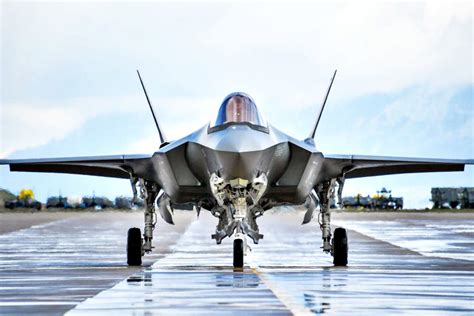
The grounding of the F-22 Raptor fleet due to a potentially critical flaw has ignited debate about the cost, operational readiness, and future role of the premier air superiority fighter in an era of evolving global threats and escalating military expenditures. With concerns ranging from oxygen system malfunctions to the overall financial burden of maintaining the aging fleet, the grounding intensifies scrutiny on the Air Force’s modernization strategies and the delicate balance between technological superiority and fiscal responsibility.
The U.S. Air Force recently grounded its entire fleet of F-22 Raptor stealth fighters, a move that has raised serious questions about the aircraft’s future and the broader implications for American air power. The grounding, triggered by an ongoing investigation into a potentially critical flaw, underscores the challenges of maintaining a complex, high-performance aircraft while balancing operational needs and budget constraints. The situation invites scrutiny of the F-22’s cost-effectiveness, its role in current and future conflicts, and the potential alternatives for ensuring U.S. air dominance.
Background of the F-22 Raptor
The F-22 Raptor, designed and manufactured by Lockheed Martin, is widely considered one of the most advanced fighter jets in the world. Conceived during the Cold War as an air superiority fighter to counter Soviet aircraft, the F-22 incorporates stealth technology, advanced avionics, and powerful engines that allow it to achieve unparalleled maneuverability and situational awareness. The aircraft first entered service in 2005 and has since been deployed in various operations, though its primary role has remained air dominance and strategic deterrence.
“The F-22 was designed to penetrate enemy airspace and destroy advanced fighters,” explains defense analyst John Harrison. “Its stealth capabilities and sensor fusion give it a significant advantage in air-to-air combat.”
However, the F-22’s development and operational history have been marked by challenges. The program was plagued by cost overruns, leading to a reduction in the number of aircraft procured. Originally, the Air Force planned to purchase 750 F-22s, but the program was capped at 187 operational aircraft due to escalating costs and shifting priorities. The final F-22 rolled off the assembly line in 2011.
The Grounding Incident: Details and Investigation
The recent grounding was prompted by an unspecified issue that could potentially compromise the safety of pilots. While the Air Force has not released specific details, reports suggest the problem may be related to the aircraft’s oxygen system, which has been a recurring concern in the past. In 2011, the F-22 fleet was temporarily grounded due to unexplained hypoxia-like symptoms experienced by pilots. The Air Force attributed the issue to a faulty oxygen system and implemented several modifications to address the problem.
According to Air Force spokesperson Colonel Melissa Johnson, “The safety of our pilots is our top priority. We are taking all necessary precautions to ensure the F-22 fleet is safe to fly.”
The current investigation involves a thorough examination of the F-22’s systems, including the oxygen system, avionics, and flight controls. Engineers and technicians are conducting inspections, analyzing data, and performing tests to identify the root cause of the problem. The Air Force is also working with Lockheed Martin, the aircraft’s manufacturer, to develop potential solutions.
Cost Considerations: A Major Point of Contention
The F-22 Raptor is one of the most expensive fighter jets ever built. The estimated unit cost, including development and procurement, is approximately $350 million. However, the total lifecycle cost, including maintenance, upgrades, and support, is significantly higher. Critics argue that the F-22’s high cost makes it an unsustainable platform for the long term, especially in an era of constrained defense budgets.
“The F-22 is a technological marvel, but it’s also a financial burden,” says defense budget analyst Sarah Miller. “The cost of maintaining and upgrading the fleet is simply too high, especially when there are other platforms that can perform similar missions at a lower cost.”
The high cost of the F-22 has also limited its deployment in overseas operations. While the aircraft has participated in exercises and patrols in various regions, it has not been used extensively in combat. This is partly due to the limited number of aircraft available and the high cost of operating and maintaining them in deployed locations.
Operational Readiness: Concerns and Challenges
The grounding incident has raised concerns about the F-22’s operational readiness. With the entire fleet grounded, the Air Force’s ability to respond to potential threats is diminished. This is particularly concerning in light of growing tensions in regions such as the Indo-Pacific, where the F-22’s air superiority capabilities are considered crucial for deterring aggression.
“The F-22 is a key component of our air defense capabilities,” says retired Air Force General David Richards. “Its absence from the skies creates a vulnerability that our adversaries could exploit.”
Maintaining the operational readiness of the F-22 fleet has been an ongoing challenge. The aircraft’s complex systems require extensive maintenance, and the availability of spare parts has been a recurring issue. The Air Force has implemented various initiatives to improve maintenance practices and streamline the supply chain, but these efforts have not fully resolved the problem.
Conflicts and the F-22’s Role: Adapting to Modern Warfare
The F-22 was designed to dominate the skies in a traditional air-to-air combat scenario. However, the nature of warfare has evolved significantly since the aircraft’s inception. Modern conflicts are often characterized by asymmetric threats, cyber warfare, and electronic warfare. The F-22’s ability to adapt to these new challenges has been a subject of debate.
Some experts argue that the F-22’s stealth capabilities and advanced sensors make it well-suited for operating in contested environments. The aircraft can penetrate enemy airspace undetected, gather intelligence, and strike targets with precision. Others contend that the F-22’s focus on air-to-air combat makes it less relevant in modern conflicts, where ground-based air defenses and electronic warfare systems pose a significant threat.
“The F-22 is still a valuable asset, but it needs to be integrated into a broader network of air and space capabilities,” says military strategist Robert Johnson. “We need to leverage its strengths while mitigating its weaknesses.”
The Future of Air Power: Alternatives and Modernization
The grounding of the F-22 has prompted discussions about the future of air power and the need for modernization. The Air Force is currently pursuing several initiatives to enhance its capabilities, including the development of the Next Generation Air Dominance (NGAD) program, which aims to produce a new fighter jet that will replace the F-22.
The NGAD program is focused on developing a more versatile and adaptable aircraft that can operate in a wider range of environments. The new fighter is expected to incorporate advanced technologies such as artificial intelligence, directed energy weapons, and advanced sensors. The Air Force hopes that the NGAD program will produce a fighter jet that can maintain U.S. air superiority for decades to come.
“The NGAD program is critical for ensuring our future air dominance,” says Air Force Chief of Staff General Charles Brown. “We need to invest in new technologies and capabilities to stay ahead of our adversaries.”
In addition to the NGAD program, the Air Force is also upgrading its existing fleet of fighter jets, including the F-35 Lightning II. The F-35 is a multi-role fighter that can perform air-to-air, air-to-ground, and electronic warfare missions. The Air Force plans to purchase over 1,700 F-35s, making it the cornerstone of its future fighter fleet.
The Role of the F-35 Lightning II
The F-35 Lightning II has emerged as a key component of the U.S. Air Force’s future air power strategy. Designed as a multi-role fighter, the F-35 is intended to complement and eventually replace older aircraft, including the F-16 and A-10. However, the F-35 has also faced its share of criticism, particularly regarding its cost, performance, and reliability.
“The F-35 is a compromise,” says aviation expert Michael Green. “It’s designed to do a little bit of everything, but it doesn’t excel in any one area. It’s also very expensive to operate and maintain.”
Despite these criticisms, the F-35 offers several advantages over older aircraft. Its stealth capabilities make it difficult to detect, and its advanced sensors provide pilots with unparalleled situational awareness. The F-35 is also equipped with a wide range of weapons, allowing it to engage a variety of targets.
International Implications: Global Air Power Balance
The grounding of the F-22 and the debate over the future of air power have significant international implications. The U.S. Air Force is a key component of American military power, and its ability to project air power around the world is a critical element of U.S. foreign policy. Any perceived weakness in U.S. air power could embolden potential adversaries and undermine U.S. credibility.
Several countries are developing their own advanced fighter jets, including China and Russia. These aircraft are designed to challenge U.S. air superiority and could potentially alter the balance of power in key regions. The U.S. Air Force needs to maintain its technological edge to deter aggression and protect U.S. interests.
“The U.S. Air Force needs to stay one step ahead of its adversaries,” says international security expert Elizabeth White. “We can’t afford to fall behind in the race for air superiority.”
Alternatives to Traditional Fighter Jets: Drones and Cyber Warfare
In addition to developing new fighter jets, the U.S. Air Force is also exploring alternative approaches to air power. Drones, or unmanned aerial vehicles (UAVs), are becoming increasingly sophisticated and capable. They can perform a wide range of missions, including reconnaissance, surveillance, and strike operations. Cyber warfare is another emerging area of focus. Cyberattacks can be used to disrupt enemy air defenses, disable aircraft, and steal sensitive information.
“Drones and cyber warfare are changing the nature of air power,” says technology analyst James Brown. “These technologies offer new ways to project power and achieve strategic objectives.”
The Air Force is investing heavily in drones and cyber warfare capabilities. It is developing new UAVs that can operate autonomously and perform complex missions. It is also training cyber warriors to defend against attacks and conduct offensive operations.
Balancing Technological Superiority and Fiscal Responsibility
The debate over the F-22 and the future of air power highlights the challenge of balancing technological superiority and fiscal responsibility. The U.S. military needs to maintain its technological edge to deter aggression and protect U.S. interests. However, it also needs to be mindful of the cost of developing and maintaining advanced weapons systems.
The Air Force is exploring various ways to reduce costs, including streamlining maintenance practices, improving supply chain management, and leveraging commercial technologies. It is also working with industry partners to develop more affordable and sustainable solutions.
“We need to find ways to maintain our technological superiority without breaking the bank,” says defense economist William Davis. “This requires a combination of innovation, efficiency, and strategic prioritization.”
Impact on Defense Contractors and the Aerospace Industry
The grounding of the F-22 and the uncertainty surrounding its future have significant implications for defense contractors and the aerospace industry. Lockheed Martin, the manufacturer of the F-22, could face financial losses if the aircraft is ultimately retired or if the Air Force reduces its investment in the program.
Other companies that supply parts and services for the F-22 could also be affected. The aerospace industry is heavily reliant on government contracts, and any major changes in defense spending can have a ripple effect throughout the sector.
“The defense industry is very sensitive to changes in government policy,” says aerospace analyst Karen Smith. “The grounding of the F-22 creates uncertainty and could lead to job losses.”
The Human Cost: Impact on Pilots and Air Force Personnel
The grounding of the F-22 also has a human cost. Pilots who fly the F-22 are highly trained and experienced. They take pride in their ability to operate the aircraft and defend the nation. The grounding of the fleet can be frustrating and demoralizing for these pilots.
“The pilots are eager to get back in the air,” says Air Force veteran Mark Thompson. “They are dedicated professionals who want to serve their country.”
The Air Force is providing support and resources to pilots and other personnel who are affected by the grounding. It is also working to keep them informed about the progress of the investigation and the plans for the future.
Political Considerations: Congressional Oversight and Influence
The future of the F-22 and the broader debate over air power are subject to political considerations. Congress plays a key role in determining defense spending and setting military priorities. Members of Congress have different views on the F-22 and the need for modernization. Some support continued investment in the aircraft, while others argue that it is too expensive and should be retired.
“Congress has a responsibility to oversee defense spending and ensure that the military is equipped to meet the challenges of the 21st century,” says Senator John Adams. “We need to make informed decisions about the F-22 and the future of air power.”
The Air Force is working to engage with Congress and provide information about the F-22 and its modernization plans. It is also seeking to build support for its budget requests and policy initiatives.
Conclusion: Navigating the Future of Air Dominance
The grounding of the F-22 Raptor underscores the complex challenges facing the U.S. Air Force as it seeks to maintain air dominance in an evolving global landscape. The situation highlights the need to balance technological superiority with fiscal responsibility, adapt to new forms of warfare, and address the operational readiness of existing platforms while investing in future capabilities. The decisions made in the coming months will have a profound impact on the future of American air power and the nation’s ability to project power around the world. The Air Force faces the critical task of ensuring it can continue to deter aggression and protect U.S. interests in an increasingly uncertain and competitive world.
Frequently Asked Questions (FAQ)
1. Why was the F-22 Raptor fleet grounded?
The F-22 Raptor fleet was grounded due to an ongoing investigation into a potentially critical flaw. While specific details have not been released, reports suggest the issue may be related to the aircraft’s oxygen system. “The safety of our pilots is our top priority,” according to Air Force spokesperson Colonel Melissa Johnson, explaining the precautionary measure.
2. How much does the F-22 Raptor cost?
The estimated unit cost of the F-22 Raptor, including development and procurement, is approximately $350 million. However, the total lifecycle cost, including maintenance, upgrades, and support, is significantly higher. This high cost has been a major point of contention and has limited the number of aircraft procured and their deployment in overseas operations.
3. What is the Next Generation Air Dominance (NGAD) program?
The Next Generation Air Dominance (NGAD) program is an Air Force initiative aimed at developing a new fighter jet to replace the F-22. This new fighter is expected to be more versatile and adaptable, incorporating advanced technologies such as artificial intelligence, directed energy weapons, and advanced sensors to maintain U.S. air superiority for decades to come. According to Air Force Chief of Staff General Charles Brown, “The NGAD program is critical for ensuring our future air dominance.”
4. How does the F-35 Lightning II factor into the future of air power?
The F-35 Lightning II is a multi-role fighter that can perform air-to-air, air-to-ground, and electronic warfare missions. The Air Force plans to purchase over 1,700 F-35s, making it a cornerstone of its future fighter fleet. While it has faced criticism regarding cost and performance, it offers advantages such as stealth capabilities and advanced sensors.
5. What are some alternative approaches to traditional fighter jets being considered by the Air Force?
The U.S. Air Force is exploring alternative approaches to air power, including drones (unmanned aerial vehicles or UAVs) and cyber warfare. Drones are becoming increasingly sophisticated and capable, performing reconnaissance, surveillance, and strike operations. Cyber warfare offers new ways to disrupt enemy air defenses and disable aircraft. The Air Force is investing heavily in these capabilities as part of its modernization strategy.









